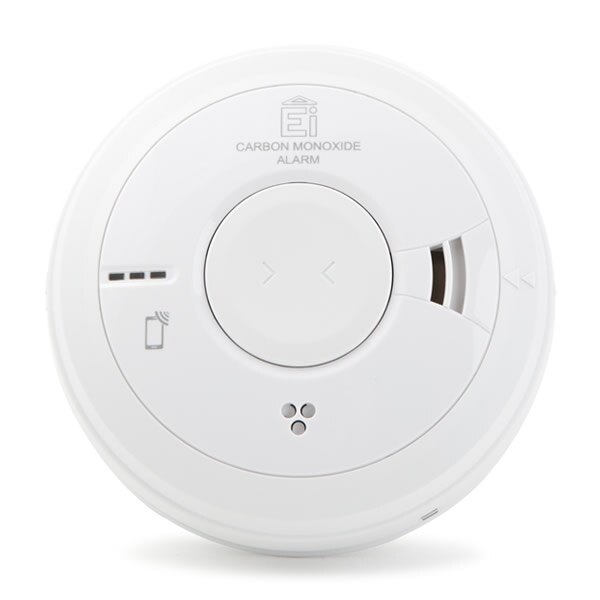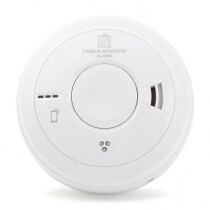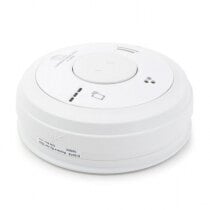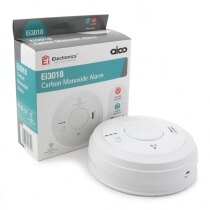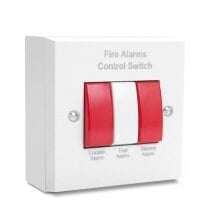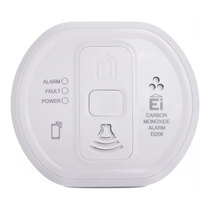-
Contact
Sales & Customer Service
0800 612 6537 support@safelincs.co.uk Live ChatDelivery Enquiries
0800 077 6149 - Resources
Fire & Safety Solutions
CALL OUR TEAM NOW 0800 612 6537
Also FREE from UK mobiles
Quick Delivery
From £4.19 inc VAT
Live Chat - Online
Instant help & Advice
Trade Discounts
and exclusive pricing
0% Credit Available
Open an account now
5 Star Customer Feedback
Mains Powered Carbon Monoxide Alarm with Self-Charging 10 Year Back-up Battery - Aico Ei3018
Product Overview
Interlink
Technical Data
FAQs (2)
The Ei3018 is a mains powered carbon monoxide alarm with built in, rechargeable lithium back-up battery to be used in the event of a mains power outage. This alarm is fitted with a high performance electrochemical sensor, designed to sense the presence of carbon monoxide. The sensor is individually calibrated and tested in CO gas to ensure accuracy. The Ei3018 also has AudioLINK technology like other alarms in the Ei3000 series meaning that you can extract real time data from the alarm via a smart phone. The alarm can be hard-wired with up to 12 other compatible devices or for radio interlinking, the Ei3000MRF module can be purchased separately and placed in the rear of the alarm.
- Product Lifespan: 10 years
- Power: 230V mains powered with battery backup
- Backup Battery: Re-chargeable lithium battery
- Warranty: 5 year warranty
- Suitable for ceiling installation
- SmartLINK compatible when used with the Ei3000MRF, introducing new features in addition as radio-interlinking
- Available in Optical, Heat, Heat & Carbon Monoxide and Optical & Heat
- Warning alarm reaches 85dB at 3m
- Hardwire interlink with up to 12 compatible devices
- AudioLINK technology allows for real time data extraction to a smart phone
- Supplied with an Easi-fit baseplate
- High performance electrochemical sensor designed to detect the presence of CO
- Performs own self-tests periodically to ensure sensor, battery and electronics are fully working
- CE and Kitemarked to BS EN 50291-1
- Compatible with Ei140, Ei160e and Ei2110e series alarms
- Memory Feature - allows previously activated alarms to be easily identified
- Central test and silence button
- This alarm is also suitable for both the Welsh and Scottish updated 2022 legislation
Please Note: The Ei3000MRF SmartLINK module for radio-interlinking is sold separately.
The tables below show all the products that can interlink with the Ei3018.
More products may be compatible when installed in conjunction with the Ei3000MRF SmartLINK module. Please see the Ei3018RF bundle for further information.
Smoke and Heat Alarms
|
Model Number
|
Type of Unit
|
Type of Interlink
|
| Ei3014 / Ei3014RF | Mains Powered Heat Alarm - Sealed Lithium | Hardwire Interlink |
| Ei3016 / Ei3016RF | Mains Powered Optical Smoke Alarm - Sealed Lithium | Hardwire Interlink |
| Ei3024 / Ei3024RF | Mains Powered Optical & Heat Alarm - Sealed Lithium | Hardwire Interlink |
| Ei3028 / Ei3028RF | Mains Powered Heat & Carbon Monoxide Alarm - Sealed Lithium | Hardwire Interlink |
| Ei2110e / Ei2110eRF | Mains Powered Multi Sensor Smoke & Heat Alarm - Sealed Lithium | Hardwire Interlink |
| Ei161e / Ei161eRF | Mains Powered Ionisation Smoke Alarm - Sealed Lithium | Hardwire Interlink |
| Ei164e / Ei164eRF | Mains Powered Heat Alarm - Sealed Lithium | Hardwire Interlink |
| Ei166e / Ei166eRF | Mains Powered Optical Smoke Alarm - Sealed Lithium | Hardwire Interlink |
| Ei141 / Ei168RC141RC | Mains Powered Ionisation Alarm - 9V Alkaline | Hardwire Interlink |
| Ei144 / Ei168RC144RC | Mains Powered Heat Alarm - 9V Alkaline | Hardwire Interlink |
| Ei146 / Ei168RC146RC | Mains Powered Optical Smoke Alarm - 9V Alkaline | Hardwire Interlink |
Carbon Monoxide Alarms
|
Model Number
|
Type of unit
|
Type of interlink
|
| Ei3018 / Ei3018RF | Mains Powered Carbon Monoxide Alarm - Sealed Lithium | Hardwire Interlink |
| Ei3028 / Ei3028RF | Mains Powered Heat & Carbon Monoxide Alarm - Sealed Lithium | Hardwire Interlink |
| Ei261 | Mains Powered Carbon Monoxide Alarm - Sealed Lithium | Hardwire Interlink |
Ancillary Products
|
Model Number
|
Type of unit
|
Type of interlink
|
| MCP401RC | Mains Powered Manual Call Point | Hardwire Interlink |
| Ei1529RC | Mains Powered Locate, Silence & Test Control Switch | Hardwire Interlink |
| Ei159 | Mains Powered Smoke Alarm Locator Switch | Hardware Interlink |
| Ei128R | Mains Powered 5A Relay Module | Hardwire Interlink |
| Ei128RBU | Mains Powered 5A Relay Module with Lithium Backup Battery | Hardwire Interlink |
| Y03 | Mains Powered Multi Frequency Sounder | Hardwire Interlink (via relay) |
| SAB300C | Mains Powered Flashing Xenon Strobe (Clear) | Hardwire Interlink (via relay) |
| SAB300R | Mains Powered Flashing Xenon Strobe (Red) | Hardwire Interlink (via relay) |
Wiring Explained
Mains powered Ei Electronics smoke and heat alarms require a 230V AC power supply and up to 12 alarms can be hardwire interlinked in one system.
To obtain a mains power supply, each alarm can be connected to the nearest lighting circuit using 2 core and earth cable with a separate, dedicated interlink cable connecting all alarms. However, if possible it is recommended that the alarms are all powered from a dedicated circuit from the distribution board using 3 core and earth cable for safety during maintenance, as the interlink cable will carry power from live alarms on other power circuits. Please see the diagram below:-
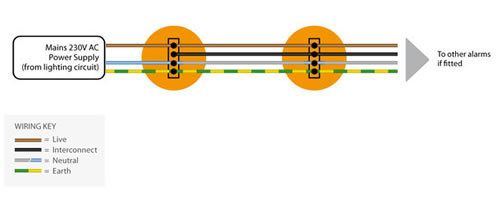
| Product Code | EI3018 |
|---|---|
| Brand | EI Electronics |
| Back-Up Battery | 10 year sealed lithium |
| Dimensions (HxDia) | 55x150mm |
| Operating Temperature | 0°C to 35°C |
| Relative Humidity | 15% to 95% Relative Humidity |
| Sound Output | 85dB |
| Weight | 0.38kg |
| Product Datasheets |
Q. Where should I install my carbon monoxide alarms?
A.
CO detectors should be installed near potential sources of carbon monoxide, essentially any fuel-burning appliances such as boilers, cookers and ovens, fireplaces (both open and enclosed burners), and portable generators. As you are likely to be most affected by CO in areas of your home that you spend the most time in it is advisable to install alarms in those areas as well, such as the living room and bedrooms. It is also worth noting that while one detector is better than no detectors at all, larger homes may require several detectors to cover the property fully.
Also note that carbon monoxide has been proven to spread into neighbouring properties through open windows and, in semi-detached or terrace houses, through loft spaces. If your property has an attached garage with a connecting door through to the house, it is recommended to fit a CO alarm inside the house leading from that doorway.
Battery powered carbon monoxide alarms can typically be installed wall-mounted or left free-standing on flat, level surface.
- Near an appliance: they should be placed within 1 to 3 metres horizontally from the appliance and between the height of the appliance to 150mm below the ceiling – i.e., not above a stove where it would be in the path of steam or fumes.
- In living spaces: they should be positioned close to where the occupant's head is likely to be most of the time – e.g., on your bedside table.
Combined smoke & CO alarms or mains-powered CO alarms are typically installed on the ceiling and should be at least 30cm away from any wall, light fitting, or other obstruction.
Do not install CO alarms within 3 metres of doors or windows, above radiators, or immediately close to anything that gives off steam or fumes like a cooker or shower room. Similarly, it is not recommended to install detectors in dusty areas such as workshops or garages.
For more information, please check the manufacturer's instructions – you can download the PDF manual from the relevant product page on our site. You can also watch our video guide to positioning CO detectors.
Q. Where are carbon monoxide alarms required?
A.
Most legislation advises at least one carbon monoxide alarm is fitted near new or replacement fuel-burning appliances that are fixed installations, though rented properties (both social and private sector) often require CO alarms be provided by landlords even if no appliances are being installed or replaced. Examples include boilers, coal fires, wood burners, and gas ovens and cookers, though an exception is often made in legislation for gas appliances solely used for cooking.
However, any and all materials can give off CO when burning, including gas cookers. Carbon monoxide can also spread from neighbouring properties or outside sources such as vehicle fumes. Because of this, Safelincs strongly recommends the installation of carbon monoxide detectors in every home, and also at head-height in bedrooms to protect occupants while sleeping.
Landlords, please see our pages for English, Welsh, and Scottish alarms or our landlord guidance page for more information.
Pricing & Availability
| Model | Stock | Price |
|---|---|---|
| Product Code: EI3018 |
Stock Level:
9 in stock Expected dispatch: 8th Jul
|
Price:
£67.91 inc VAT £56.59 ex VAT |
Delivery Options
The following delivery options are available on this product.
Customer Reviews
1 customer has given this product an overall rating of 4 out of 5
Reviews by real customers
All of our product reviews are written by real customers that have purchased this product from us and are published without modification.Rating: 4 / 5 Stars
Reviewed by: G R
Excellent product good service Quick delivery and good price
Published on: 28th July 2022
Looking for more information?
If you have any questions or would like more information about this product you can ask one of our specialists.
Live Chat Available Now
Direct Telephone
01507 464182




















